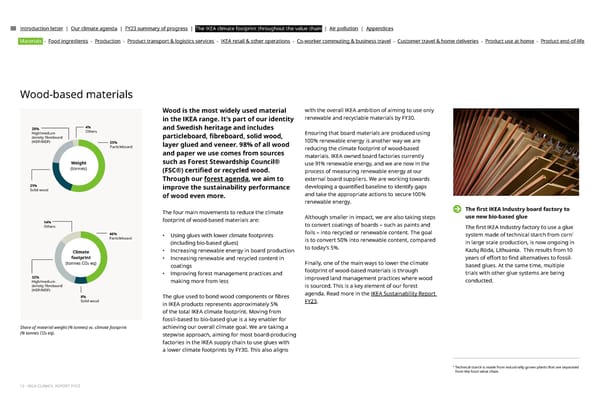Introduction letter | Our climate agenda | FY23 summary of progress | The IKEA climate footprint throughout the value chain | Air pollution | Appendices Materials - Food ingredients - Production - Product transport & logistics services - IKEA retail & other operations - Co-worker commuting & business travel - Customer travel & home deliveries - Product use at home - Product end-of-life Wood-based materials Wood is the most widely used material with the overall IKEA ambition of aiming to use only in the IKEA range. It's part of our identity renewable and recyclable materials by FY30. 20% 4% and Swedish heritage and includes High/medium Others Ensuring that board materials are produced using particleboard, 昀椀breboard, solid wood, density 昀椀breboard 100% renewable energy is another way we are (HDF/MDF) 55% layer glued and veneer. 98% of all wood Particleboard reducing the climate footprint of wood-based and paper we use comes from sources materials. IKEA owned board factories currently Weight such as Forest Stewardship Council® use 91% renewable energy, and we are now in the (tonnes) (FSC®) certi昀椀ed or recycled wood. process of measuring renewable energy at our Through our forest agenda, we aim to external board suppliers. We are working towards 21% Solid wood improve the sustainability performance developing a quanti昀椀ed baseline to identify gaps of wood even more. and take the appropriate actions to secure 100% renewable energy. The four main movements to reduce the climate The 昀椀rst IKEA Industry board factory to footprint of wood-based materials are: Although smaller in impact, we are also taking steps use new bio-based glue 14% to convert coatings of boards – such as paints and Others foils – into recycled or renewable content. The goal The 昀椀rst IKEA Industry factory to use a glue 46% system made of technical starch from corn1 Particleboard • Using glues with lower climate footprints is to convert 50% into renewable content, compared in large scale production, is now ongoing in (including bio-based glues) to today’s 5%. Climate • Increasing renewable energy in board production Kazlų Rūda, Lithuania. This results from 10 footprint • Increasing renewable and recycled content in years of e昀昀ort to 昀椀nd alternatives to fossil- (tonnes CO2 eq) coatings Finally, one of the main ways to lower the climate based glues. At the same time, multiple • Improving forest management practices and footprint of wood-based materials is through trials with other glue systems are being 32% improved land management practices where wood conducted. High/medium making more from less density 昀椀breboard is sourced. This is a key element of our forest (HDF/MDF) agenda. Read more in the IKEA Sustainability Report 8% The glue used to bond wood components or 昀椀bres Solid wood in IKEA products represents approximately 5% FY23. of the total IKEA climate footprint. Moving from fossil-based to bio-based glue is a key enabler for Share of material weight (% tonnes) vs. climate footprint achieving our overall climate goal. We are taking a (% tonnes CO2 eq). stepwise approach, aiming for most board-producing factories in the IKEA supply chain to use glues with a lower climate footprints by FY30. This also aligns 1 Technical starch is made from industrially grown plants that are separated from the food value chain. 12 - IKEA CLIMATE REPORT FY23
 IKEA CLIMATE Report FY23 Page 11 Page 13
IKEA CLIMATE Report FY23 Page 11 Page 13